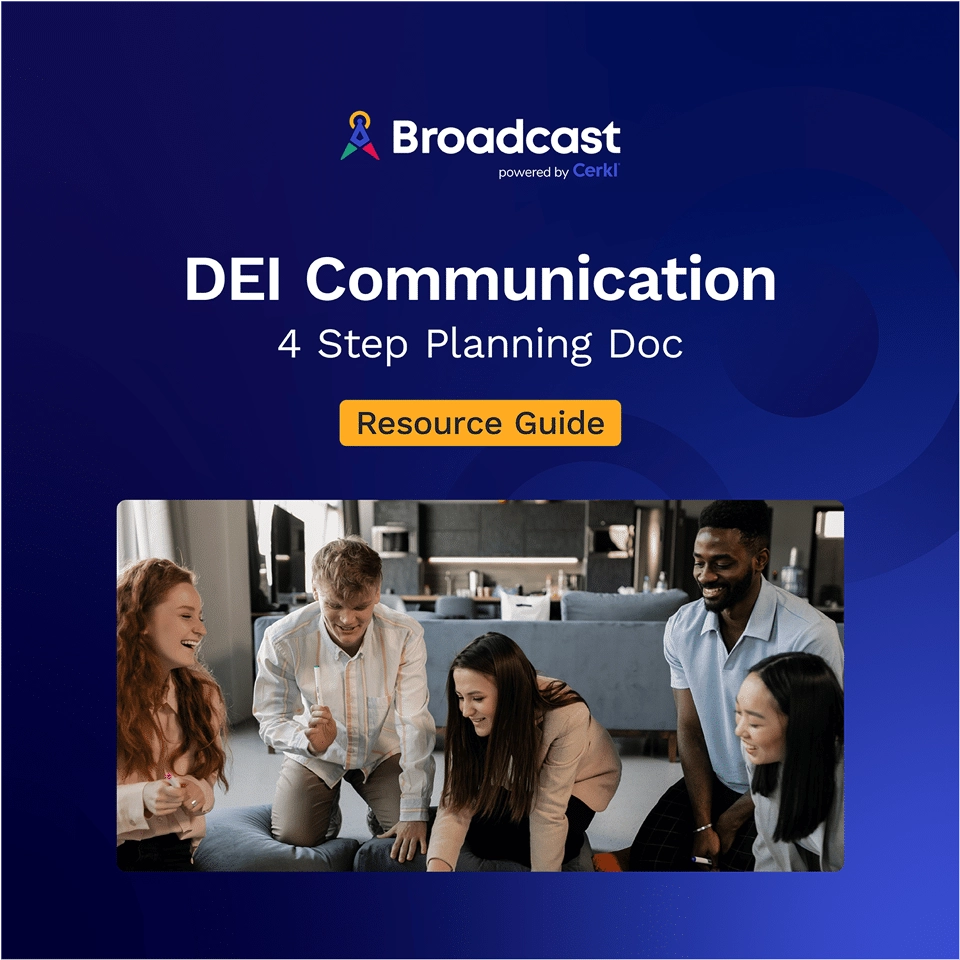DEI in healthcare is more important than many companies realize. Even those who know it’s important fail. With our guidance your DEI initiatives will succeed.


Communications around Diversity, Equity, and Inclusion (DEI) need to be strategic, thoughtful, and empathetic. Ensure your DEI communications are up to standards with our 4 step planning document.
Access NowResearch shows that diverse organizations excel at attracting talent, making strong decisions, and driving innovation. So says McKinsey & Company, which prioritizes the “moral imperatives” of diversity, equity, and inclusion (DEI). But they also warn that “the value of diversity is only fully captured when an organization is equitable and inclusive.”
An inclusive and equitable environment, fostered by leadership and colleagues, ensures a fair, welcome space for everyone. This, in turn, unlocks the full potential of a diverse workforce, preventing the loss of valuable opportunities, talent, and untapped potential.
However, in their The State of Organizations 2023 report, they state that while 70% of organizations responding to their survey aim to make meaningful progress on DEI, less than half of them have the infrastructure to realize their aspirations. They also state that while diversity initiatives have progressed, equity and inclusion efforts tend to lag behind.
The World Health Organization (WHO) acknowledges that “significant progress” has been made globally to improve the wellbeing and health of everyone. But they also concede that there’s still a lot to be done “to advance gender equality, human rights, and health equity, and to ensure that no one’s health is left behind.
"Discrimination, human rights violations and abuses, poverty, and other determinants of health, underlie many health disparities and intersect in ways that limit people’s abilities to make decisions about their own health, impede access to quality health care, and worsen physical and mental health outcomes."
WHO
Ultimately, the DEI aim of WHO is to ensure that “equity-oriented, gender-responsive, and human right-based approaches” are integrated into their work.
An enormous amount has been researched and written about DEI (also known as DE&I) and its various elements. So, we’re going to discuss DEI in general terms and then focus on DEI and inclusive healthcare communications.
All communications plans need to be constantly kept up to date. Technologies keep changing, and focused communications companies develop new software for specific needs.
Modernizing healthcare communication requires a multi-pronged approach that considers both internal and external communication strategies. Here are some key steps an organization in the healthcare industry can take.
The goal is to have inclusive healthcare communications.
A good start is to be sure you are embracing secure and compliant technology. Make sure that you use secure messaging platforms, team collaboration tools, and communication channels that all comply with HIPAA regulations. This includes managing BYOD in healthcare to keep personal devices secure and compliant. This streamlines information flow, facilitates efficient collaboration and protects patient data.
Invest in accessible training so that employees understand effective communication techniques. The focus here should be on active listening, clear and concise communication, and cultural sensitivity. This will help to foster better teamwork, improve patient interactions, and ensure a clear exchange of information across departments.
It’s also important to promote two-way communication. Encourage open communication channels where staff at all levels feel comfortable raising concerns, providing feedback, and asking questions. This promotes a collaborative environment and improves employee satisfaction.
Our healthcare employee engagement report provides more information about how you can increase engagement within your organization.
An omnichannel approach makes 100% sense. Utilize various communication channels, including email, text messages, patient portals, social media, and even video conferencing for consultations. This caters to diverse patient preferences and ensures accessibility of information.
It’s also important to leverage patient portals online so patients can schedule appointments. Also consider allowing patients to use these portals to access medical records, communicate with providers, and manage their health information. This empowers patients and streamlines communication. Emerging technologies such as AI agents in healthcare are increasingly integrated into these platforms, providing personalized support and improving patient engagement.
Embrace transparency and empathy and communicate openly and honestly with patients about wait times, appointment changes, and any unexpected situations. Make sure that communication is empathetic so you can build trust and address patient concerns effectively.
Another area to embrace is patient education. It’s important to develop clear, concise, and culturally sensitive educational materials to inform patients about their health conditions, treatment options, and preventive measures. This empowers patients to be active participants in their healthcare journey. It’s also an important step in DEI.
Diversity, equity, and inclusion are closely linked values that support different groups of individuals, including people of different races, ethnicities, religions, abilities, genders, and sexual orientations. In an article, What is diversity, equity, and inclusion? McKinsey states that diversity is about who is represented in the workforce, equity is the fair treatment of all people, and inclusion is about how the workforce experiences the workplace and how they can make meaningful contributions.
Organizations need to be able to implement and maintain long-term goals and strategies in order to provide equitable and accessible services through effective communication strategies in healthcare.

A commitment to DEI in the healthcare industry attracts and retains a diverse and talented workforce, saving the costs of a high employee turnover.
Organizations that prioritize DEI become more attractive to diverse candidates who seek workplaces that value diversity and offer equal opportunities for growth and advancement.
Research by New Eagle Hill Consulting shows that DEI is a key factor when considering employment with another company. On average, 53% find this important, but it is an even more critical factor for younger workers, with GenZ at 77% and Millennials at 63%. The eye-opener is that this same research found that only 29% of employees say their organizations have actively demonstrated their commitment to DEI in the past six months.
Eagle Hill Consulting CEO Melissa Jezior says that the new research shows that DEI is a priority issue for “a large share of the workforce.” And even though some companies are reducing their DEI staff and programs, other employers are increasing their DEI efforts.
"Smart employers are tapping into this employee sentiment and ensuring their culture creates a welcoming and supportive environment for all segments of their workforce. A culture where employees feel valued and connected is a competitive factor when it comes to attracting and keeping top workers."
Melissa Jezior
Ensure your company's communications promote diversity, equity, and inclusion

In an article, It’s (past) time to get strategic about DEI, McKinsey notes five critical steps for setting and achieving successful DEI strategies:
This is good to know, but research published in Implementation Science tells us, to move towards DEIB — which adds belonging to diversity, equity, and inclusion — it’s vital not only to establish interventions, but to also implement them successfully.
Interestingly, this research was specifically aimed at strategies implemented by top-level leaders to support DEIB in healthcare organizations.
“Many HCOs have made public statements declaring that they are committed to addressing health inequities and improving their workplace so all employees can be successful and contribute. To move beyond words, and bring the type of change that is needed, the organization must focus on not only establishing a strategic plan that embodies DEIB strategies and interventions, but also implementing them.”
Quoted in Implementation Science
There are many proven benefits to DEI and all of the good it can bring to an organization.
However, there are obstacles in the way of success, like communication barriers in healthcare. Whether they are cultural, linguistic, or otherwise, they decrease the effectiveness of the healthcare system.
For example, a major problem is the lack of communication and DEI training that medical professionals have. While it may not seem as important, communication skills are vital for patients and peers alike and they are severely lacking.
Language barriers can also hinder effective healthcare communication. In a 2023 study, BMC Health Services Research found that the impacts of language barriers on patients include preventable medical errors, low treatment adherence, low health-seeking behavior, additional treatment cost, increased length of hospital stays, and dissatisfaction with healthcare.

There are various ways that DEI can be implemented in healthcare. For example, it can increase diversity in the workplace, improve culturally competent healthcare, address health disparities, and improve inclusive leadership.
Here are some typical examples of DEI in healthcare.
Good ways to improve diversity in the workplace are to actively recruit diverse candidates and develop inclusive hiring practices. You can also establish mentorship programs. Ultimately, you want to mitigate unconscious bias and ensure a fair evaluation process for all candidates.
Translation services and multilingual educational materials will ensure clear communication and understanding of medical information for patients with limited English proficiency.
It is also important to provide training for healthcare professionals on cultural competency, including understanding different health beliefs, practices, and communication styles across diverse populations.
A good way to overcome health disparities is to partner with community organizations to conduct health screenings and provide education on preventative health measures. It’s also important to collect and analyze data to identify and address racial, ethnic, and socioeconomic disparities in healthcare access, quality of care, and health outcomes.
Diversity at leadership levels starts by promoting and cultivating diversity within leadership positions to ensure decision-making processes reflect the perspectives of different backgrounds and experiences. Those at the top need to foster an organizational culture where open communication, feedback, and diverse perspectives are valued and encouraged at all levels.
Ensure your company's communications promote diversity, equity, and inclusion

Effective communication strategies play a vital role in promoting DEI initiatives within healthcare organizations. By implementing a plan to incorporate DEI in communication, healthcare providers can foster a culture that values diversity, ensures equity, and promotes inclusion at all levels. Here are our top five DEI initiatives for better communication strategies in healthcare.
Maintaining a sustainable culture of DEI in the healthcare industry requires a long-term commitment and a comprehensive approach. Leadership buy-in and commitment are crucial for driving DEI initiatives. If they don’t really care and commit to DEI, then they can’t expect the rest of the company to follow.
Through their internal communication, leaders should communicate the importance of it. It could be DEI exclusive communications or through the messaging used to communicate with their employees. It is important to set clear goals and expectations, allocate resources, and hold themselves and others accountable for fostering an inclusive culture with patients but also with employees.
The language you use matters significantly and can promote diversity and inclusion in healthcare organizations.
It’s a well known fact that communities of color, lower socioeconomic status, rural communities, people with disabilities, and LGBTQ+ individuals are disproportionately exposed to situations and environments that negatively impact health risks and outcomes. This can lead to higher rates of health disparities. If these groups of people feel isolated by the language they hear in their healthcare, then they might feel inclined to skip the doctor which could make their health outcomes even worse.
Some steps to overcoming communication barriers in healthcare include using inclusive language while talking to co-workers or to patients. Ensure messaging is inclusive and respectful of diverse identities and experiences. Even when writing communications, use gender-neutral language when appropriate and ask individuals how they prefer to be addressed, like with their pronouns. While collecting information, avoid making assumptions about individuals based on stereotypes and try to approach every person with an open mind.
It is crucial that language barriers are carefully considered when you promote diversity and inclusion in healthcare organizations. It is important that people are constantly on call and can be reached when a translator is needed. This is why the implementation of an internal communication platform is useful for this demand. Just be sure to use trained interpreters rather than relying on family members or friends to ensure accurate communication.
DEI in the healthcare industry is also about recognizing that not all employees are alike based on the preferences and characteristics of various groups.
Segmentation is a basic technique for building a program that fosters diversity. By learning what motivates each group of employees, offering a customized communication program, and aligning the workforce under a single vision, companies may be able to maximize their shared value of DEI and increase both productivity and sustainability.
A good internal communication strategy is to assign an employee to help when patients struggle with English as a second language or there are location concerns.

Feedback is a vital strategy to assess the current state of DEI within any healthcare organization. It is one of the most effective ways to identify strengths, weaknesses, and areas for improvement. If you don’t know what the starting point is, then there is no way to measure how much you have grown.
The first step you can take is to communicate the purpose and importance of their contributions. Clearly communicate to employees why their feedback matters. Let them know that it’s an opportunity to improve the workplace and make it more inclusive for everyone. The US Office of Personnel Management says that it is critical to improving performance. Especially if you want to lessen the communication barriers in healthcare, you need to emphasize that the feedback will get used and that it’s vital to the process.
It’s also important to create a safe and anonymous feedback mechanism. Establish a confidential and secure channel for employees to share their thoughts and experiences regarding diversity and inclusion in healthcare organizations. This can be an anonymous suggestion box, an online survey, or an email address dedicated to DEI feedback.
For instance, in an email blast, add a poll to see if everyone is on the same page or if there might be some room to adjust.

Establishing metrics and data collection processes to measure progress on DEI goals is especially important for communication strategies in healthcare.
Harvard Business Review says that in order to make lasting DEI progress in healthcare, organizations need to measure outcomes. With analytics and insights, you can regularly evaluate and report on DEI efforts in internal communication to measure internal effectiveness. Transparently share progress and challenges with stakeholders.
After all of this information is collected, develop a comprehensive DEI strategic plan that aligns with your organization’s mission, values, and goals. Set specific, measurable, attainable, relevant, and time-bound (SMART) objectives. Ensure the plan has the necessary resources and support for implementation to decrease barriers in healthcare communication.
Healthcare organizations need to be aware of the positive aspects that DEI has on healthcare outcomes for patients and operations for employees. Some of the benefits of diversity and inclusion in healthcare organizations include higher retention, increased trust, and increased employee engagement. But in order to get there, healthcare executives need to use more communication strategies in healthcare so they can commit to the DEI results. Measuring communication success, using inclusive language, and buying into leadership make the difference between a distant dream and actual results.
Cerkl Broadcast is a versatile platform that provides a centralized hub for streamlined internal communications. It manages all communication assets for any size organization. It also enables strategic scheduling allowing you to schedule content for optimal impact with drag-and-drop templates. Another great feature is that you can segment content for optimal impact using drag-and-drop templates.
Omnichannel delivery, which is ideal for the healthcare industry, lets employees choose and use their preferred channels. You can also segment audiences for precise messaging based on department, role, or location.
Metrics are always important. So, the platform allows you to track communication performance with ease. Then you can measure message effectiveness with analytics to improve future communication plans.
Supercharge your internal communication strategies and break down communication barriers within your healthcare organization. Discover how to foster inclusivity and embrace diversity and inclusion in healthcare organizations for a stronger, more cohesive team.
Take the first step towards a more effective and collaborative work environment with our interactive diversity, equity, and inclusion communication checklist.

Ensure your company's communications promote diversity, equity, and inclusion
What is DEI healthcare? Diversity, equity, and inclusion (DEI) in healthcare involves efforts and strategies within the healthcare industry to promote a diverse workforce, ensure fair and equitable access to healthcare, and foster an inclusive environment that considers the unique needs of all individuals, irrespective of their background or identity.
What does DEI mean in medicine? DEI in medicines is essentially the same as DEI in healthcare, but more focused on medical issues. Broadly, it encompasses initiatives and practices aimed at creating a system that is diverse and ensures fair access to care, including hospitalization, medication, surgery, and mental health. The goal is to address disparities, improve healthcare outcomes, and ensure that medical practices are considerate of the diverse needs of individuals and communities.
Why is DEI important for patient care? DEI is vital for patient care as it ensures fair access, culturally competent services, and an inclusive environment for every individual seeking healthcare. This approach contributes to improved healthcare outcomes and patient satisfaction. It also helps to address and mitigate disparities in the delivery of healthcare of all kinds.
What is an example of DEI? An example of DEI in the healthcare industry is implementing language-access services to ensure that patients with limited English skills can communicate effectively with healthcare providers and receive equitable care. Another example is establishing cultural competency training for healthcare professionals to improve their understanding of diverse patient needs and backgrounds.

Ensure your company's communications promote diversity, equity, and inclusion